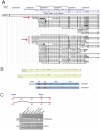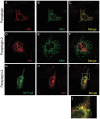Alternative splicing of Spg7, a gene involved in hereditary spastic paraplegia, encodes a variant of paraplegin targeted to the endoplasmic reticulum
- PMID: 22563492
- PMCID: PMC3341365
- DOI: 10.1371/journal.pone.0036337
Alternative splicing of Spg7, a gene involved in hereditary spastic paraplegia, encodes a variant of paraplegin targeted to the endoplasmic reticulum
Abstract
Background: Hereditary spastic paraplegia defines a group of genetically heterogeneous diseases characterized by weakness and spasticity of the lower limbs owing to retrograde degeneration of corticospinal axons. One autosomal recessive form of the disease is caused by mutation in the SPG7 gene. Paraplegin, the product of SPG7, is a component of the m-AAA protease, a high molecular weight complex that resides in the mitochondrial inner membrane, and performs crucial quality control and biogenesis functions in mitochondria.
Principal findings: Here we show the existence in the mouse of a novel isoform of paraplegin, which we name paraplegin-2, encoded by alternative splicing of Spg7 through usage of an alternative first exon. Paraplegin-2 lacks the mitochondrial targeting sequence, and is identical to the mature mitochondrial protein. Remarkably, paraplegin-2 is targeted to the endoplasmic reticulum. We find that paraplegin-2 exposes the catalytic domains to the lumen of the endoplasmic reticulum. Moreover, endogenous paraplegin-2 accumulates in microsomal fractions prepared from mouse brain and retina. Finally, we show that the previously generated mouse model of Spg7-linked hereditary spastic paraplegia is an isoform-specific knock-out, in which mitochondrial paraplegin is specifically ablated, while expression of paraplegin-2 is retained.
Conclusions/significance: These data suggest a possible additional role of AAA proteases outside mitochondria and open the question of their implication in neurodegeneration.
Conflict of interest statement
Figures





Similar articles
-
Variable and tissue-specific subunit composition of mitochondrial m-AAA protease complexes linked to hereditary spastic paraplegia.Mol Cell Biol. 2007 Jan;27(2):758-67. doi: 10.1128/MCB.01470-06. Epub 2006 Nov 13. Mol Cell Biol. 2007. PMID: 17101804 Free PMC article.
-
Impaired flickering of the permeability transition pore causes SPG7 spastic paraplegia.EBioMedicine. 2020 Nov;61:103050. doi: 10.1016/j.ebiom.2020.103050. Epub 2020 Oct 9. EBioMedicine. 2020. PMID: 33045469 Free PMC article.
-
Whole-exome sequencing identifies homozygous AFG3L2 mutations in a spastic ataxia-neuropathy syndrome linked to mitochondrial m-AAA proteases.PLoS Genet. 2011 Oct;7(10):e1002325. doi: 10.1371/journal.pgen.1002325. Epub 2011 Oct 13. PLoS Genet. 2011. PMID: 22022284 Free PMC article.
-
m-AAA proteases, mitochondrial calcium homeostasis and neurodegeneration.Cell Res. 2018 Mar;28(3):296-306. doi: 10.1038/cr.2018.17. Epub 2018 Feb 16. Cell Res. 2018. PMID: 29451229 Free PMC article. Review.
-
Translating m-AAA protease function in mitochondria to hereditary spastic paraplegia.Trends Mol Med. 2006 Jun;12(6):262-9. doi: 10.1016/j.molmed.2006.04.002. Epub 2006 May 2. Trends Mol Med. 2006. PMID: 16647881 Review.
Cited by
-
Mitochondrial Diseases Part II: Mouse models of OXPHOS deficiencies caused by defects in regulatory factors and other components required for mitochondrial function.Mitochondrion. 2015 May;22:96-118. doi: 10.1016/j.mito.2015.01.008. Epub 2015 Jan 29. Mitochondrion. 2015. PMID: 25640959 Free PMC article. Review.
-
Charting the genetic landscape of autosomal recessive hereditary spastic paraplegia: A deep dive into 10 exceptionally rare cases.Neurogenetics. 2025 Aug 9;26(1):58. doi: 10.1007/s10048-025-00841-8. Neurogenetics. 2025. PMID: 40782215
-
Compound heterozygote mutations in SPG7 in a family with adult-onset primary lateral sclerosis.Neurol Genet. 2016 Mar 3;2(2):e60. doi: 10.1212/NXG.0000000000000060. eCollection 2016 Apr. Neurol Genet. 2016. PMID: 27123479 Free PMC article.
-
Spastin mutations impair coordination between lipid droplet dispersion and reticulum.PLoS Genet. 2020 Apr 21;16(4):e1008665. doi: 10.1371/journal.pgen.1008665. eCollection 2020 Apr. PLoS Genet. 2020. PMID: 32315314 Free PMC article.
-
Spatial and temporal dynamics of the cardiac mitochondrial proteome.Expert Rev Proteomics. 2015 Apr;12(2):133-46. doi: 10.1586/14789450.2015.1024227. Epub 2015 Mar 9. Expert Rev Proteomics. 2015. PMID: 25752359 Free PMC article. Review.
References
-
- Harding AE. Hereditary spastic paraplegias. Semin Neurol. 1993;13:333–336. - PubMed
-
- Reid E, Rugarli EI. In: Valle, Beaudet, Vogelstein, Kinzler, Antonarakis, et al., editors. Scriver's Online Metabolic and Molecular Bases of Inherited Diseases; 2010.
-
- Casari G, De Fusco M, Ciarmatori S, Zeviani M, Mora M, et al. Spastic paraplegia and OXPHOS impairment caused by mutations in paraplegin, a nuclear-encoded mitochondrial metalloprotease. Cell. 1998;93:973–983. - PubMed
-
- Arnoldi A, Tonelli A, Crippa F, Villani G, Pacelli C, et al. A clinical, genetic, and biochemical characterization of SPG7 mutations in a large cohort of patients with hereditary spastic paraplegia. Hum Mutat. 2008;29:522–531. - PubMed
Publication types
MeSH terms
Substances
LinkOut - more resources
Full Text Sources
Molecular Biology Databases

